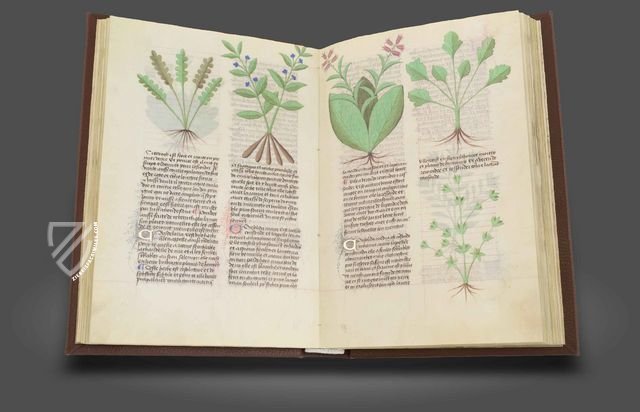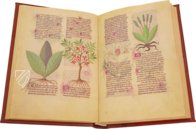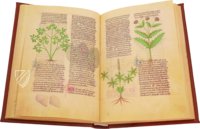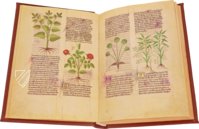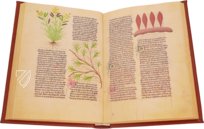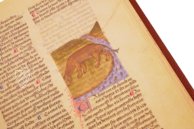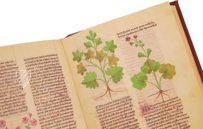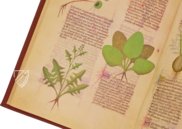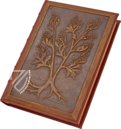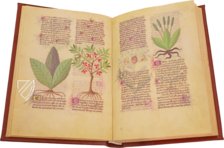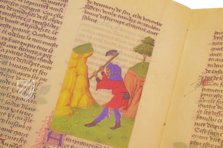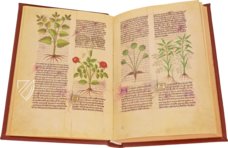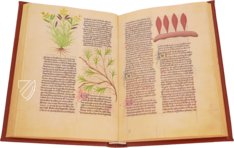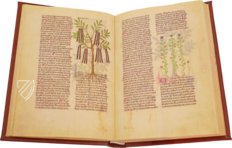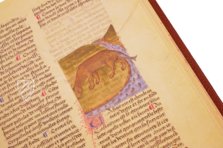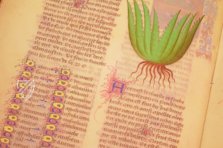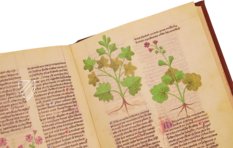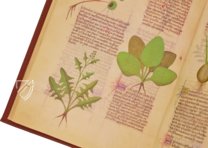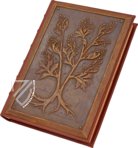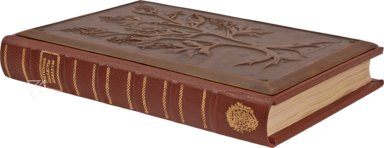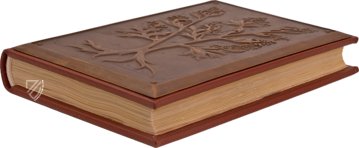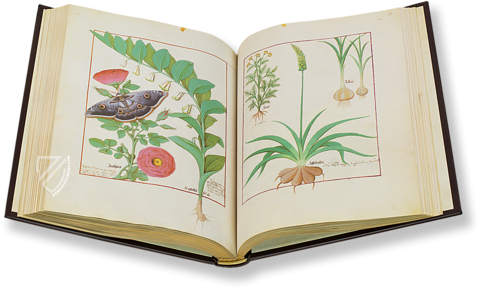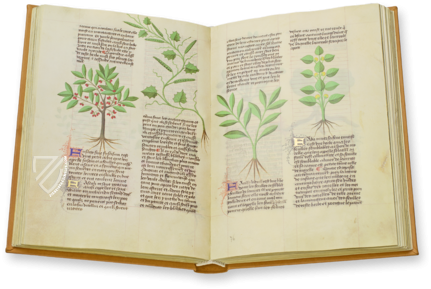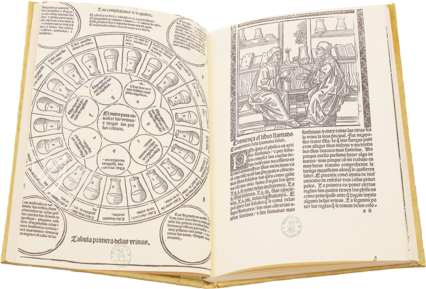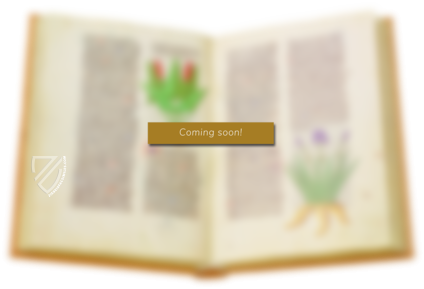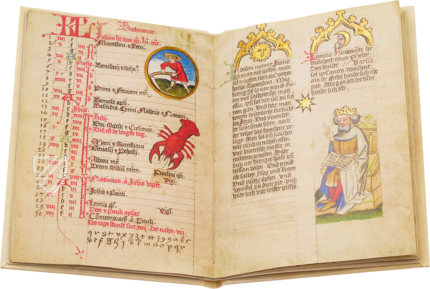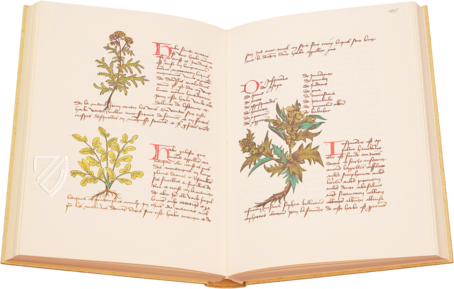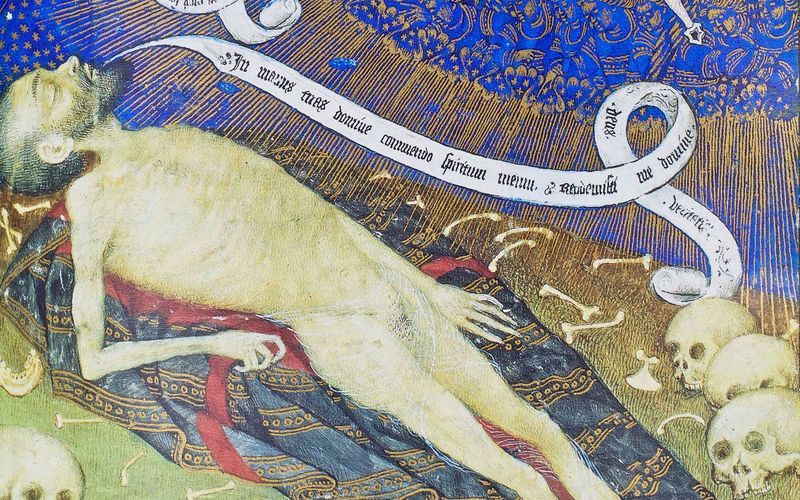Fascination of Medical Plants
One of the most famous writings on medicine and botany of the Middle Ages: De simplicibus medicinis by Matthäus Platearius. This work by the renowned physician of the School of Salerno lists 500 plants, herbs, and other remedies, some of which are also of animal origin. Remarkably, they are arranged alphabetically, which was by no means the norm in the Middle Ages. The extensive text provides fascinating and often somewhat mystical information about their extraction, application, and effects on the human body. Created in France in the second half of the 15th century, this precious manuscript contains a French translation of the influential text and is magnificently illuminated with beautiful illustrations of the remedies described. In addition, there are precious, gilded decorated initials that clearly demonstrate the wealth of the unknown patron and the representational purpose of the manuscript. This codex was not used by a physician on a daily basis, but rather served to display the erudition of its owner.
Fascination of Medical Plants
One of the most famous texts concerning medicine and botany of the Middle Ages in a precious luxury edition: De simplicibus medicinis by Matthaeus Platearius. This work by the famous physician from the Salerno school listed 500 plants, herbs, and other remedies with instructions for their production, application, and effect. In his precious manuscript, originating ca. 1500 in France, the French translation of the text is accompanied by gorgeous illustrations, depictions of the remedies are also presented. Handsome gilded initials additionally embellish this edition and make its standing as a gem of illumination clear!
The French Translation of a Medieval Standard Work
Two herbaria from the 15th century are stored in the Biblioteca Estense Universitaria in Modena. One of them is the famous Herbolaire, also known as the Grant Herbier. This wonderful manuscript is a comprehensive illustrated edition of the medical-botanical text of De simplicibus medicinis by Platerius. This scientific codex makes up the foundation of a French translation with the title Livre des simples medicinis, which originates from France in the second half of the 15th century.
A Physician
Matthaeus Platearius was a famous physician from the Salerno school. Emulating a Dioscorides, he composed a botanical medical textbook that became one of the most famous medical books of the Middle Ages: De simplicibus medicinis (Of Simple Remedies). There are 500 efficacious plants and remedies in it with comprehensive information about their production, application, effect, and other themes and is arranged alphabetically for a better overview.
The Marvelous Illustrations
This particularly impressive edition of the famous text was surely the commission of a high-ranking personality. Each of the 340 pages is gorgeously illustrated, sometimes even with multiple depictions. The plants and remedies represented were realistically illustrated with detailed depictions of roots, leaves, fruits, and flowers. Additionally, animals, minerals, and figurative scenes of rural work, which depict the mining of sulfur or the collecting of aloe branches, can be found. Precious small Fleuronné initials, sometimes even accentuated with gold leaf, round out the impressive work!
Codicology
- Alternative Titles
- Herbolaire Estense
Grant Herbier
Dictionar Gallicum Herbarum
Estense Herbal
Livre des simples medecines - Size / Format
- 340 pages / 28.0 × 20.0 cm
- Origin
- France
- Date
- Second half of the 15th century
- Epochs
- Style
- Language
- Script
- French littera bastarda
- Illustrations
- One or more illustrations of plants, animals and humans on nearly every page
- Content
- French translation of De simplicibus medicinis
- Artist / School
- Matthaeus Platearius (author)
Jehan Duboys (scribe) - Previous Owners
- Honoré d'Urfé, marquis de Valromey, comte de Châteauneuf (1568–1625)
Jehan Duboys
Fascination of Medical Plants
Whale
Some animals can usually be found in herbal manuscripts, especially those that can be used for manufacturing remedies or other practical applications. Aside from being the largest mammals on earth, whales were also precious sources for meat, blubber, oil, and various products that can be made from their bones and baleen, which can be seen in the open mouth of the whale depicted here. Its blowhole is slightly off-center, and it looks back at the beholder with understandable hostility.

Fascination of Medical Plants
Allium and Asphodelus
Introduced by a shimmering golden “A”, the chapter concerning Allium sativum or garlic is a species of bulbous flowering plant in the onion genus Allium that has been used for medicinal purposes around the world for millennia. The famous Persian physician Avicenna recommended it for treating arthritis, snake and insect bites, parasites, chronic cough, and as an antibiotic.
Depicted on the left is Asphodelus, a genus of mainly perennial flowering plants with a spike that blooms with white or yellow flowers. It was supposed to be a remedy for poisonous snakebites and a specific against sorcery that was somehow fatal to mice but preserved pigs from disease. In Greek mythology, it is one of the most famous plants connected to the underworld.

- Treatises / Secular Books
- Apocalypses / Beatus
- Astronomy / Astrology
- Bestiaries
- Bibles / Gospels
- Chronicles / History / Law
- Geography / Maps
- Saints' Lives
- Islam / Oriental
- Judaism / Hebrew
- Single Leaf Collections
- Leonardo da Vinci
- Literature / Poetry
- Liturgical Manuscripts
- Medicine / Botany / Alchemy
- Music
- Mythology / Prophecies
- Psalters
- Other Religious Books
- Games / Hunting
- Private Devotion Books
- Other Genres
- Afghanistan
- Armenia
- Austria
- Belgium
- Belize
- Bosnia and Herzegovina
- China
- Colombia
- Costa Rica
- Croatia
- Cyprus
- Czech Republic
- Denmark
- Egypt
- El Salvador
- Ethiopia
- France
- Germany
- Greece
- Guatemala
- Honduras
- Hungary
- India
- Iran
- Iraq
- Israel
- Italy
- Japan
- Jordan
- Kazakhstan
- Kyrgyzstan
- Lebanon
- Liechtenstein
- Luxembourg
- Mexico
- Morocco
- Netherlands
- Palestine
- Panama
- Peru
- Poland
- Portugal
- Romania
- Russia
- Serbia
- Spain
- Sri Lanka
- Sweden
- Switzerland
- Syria
- Tajikistan
- Turkey
- Turkmenistan
- Ukraine
- United Kingdom
- United States
- Uzbekistan
- Vatican City
- A. Oosthoek, van Holkema & Warendorf
- Aboca Museum
- Ajuntament de Valencia
- Akademie Verlag
- Akademische Druck- u. Verlagsanstalt (ADEVA)
- Aldo Ausilio Editore - Bottega d’Erasmo
- Alecto Historical Editions
- Alkuin Verlag
- Almqvist & Wiksell
- Amilcare Pizzi
- Andreas & Andreas Verlagsbuchhandlung
- Archa 90
- Archiv Verlag
- Archivi Edizioni
- Arnold Verlag
- ARS
- Ars Magna
- ArtCodex
- AyN Ediciones
- Azimuth Editions
- Badenia Verlag
- Bärenreiter-Verlag
- Belser Verlag
- Belser Verlag / WK Wertkontor
- Benziger Verlag
- Bernardinum Wydawnictwo
- BiblioGemma
- Biblioteca Apostolica Vaticana (Vaticanstadt, Vaticanstadt)
- Bibliotheca Palatina Faksimile Verlag
- Bibliotheca Rara
- Boydell & Brewer
- Bramante Edizioni
- Bredius Genootschap
- Brepols Publishers
- British Library
- C. Weckesser
- Caixa Catalunya
- Canesi
- CAPSA, Ars Scriptoria
- Caratzas Brothers, Publishers
- Carus Verlag
- Casamassima Libri
- Centrum Cartographie Verlag GmbH
- Chavane Verlag
- Christian Brandstätter Verlag
- Circulo Cientifico
- Club Bibliófilo Versol
- Club du Livre
- CM Editores
- Collegium Graphicum
- Collezione Apocrifa Da Vinci
- Comissão Nacional para as Comemorações dos Descobrimentos Portugueses
- Coron Verlag
- Corvina
- CTHS
- D. S. Brewer
- Damon
- De Agostini/UTET
- De Nederlandsche Boekhandel
- De Schutter
- Deuschle & Stemmle
- Deutscher Verlag für Kunstwissenschaft
- DIAMM
- Droz
- E. Schreiber Graphische Kunstanstalten
- Ediciones Boreal
- Ediciones Grial
- Ediclube
- Edições Inapa
- Edilan
- Editalia
- Edition Deuschle
- Edition Georg Popp
- Edition Leipzig
- Edition Libri Illustri
- Editiones Reales Sitios S. L.
- Éditions de l'Oiseau Lyre
- Editions Medicina Rara
- Editorial Casariego
- Editorial Mintzoa
- Editrice Antenore
- Editrice Velar
- Edizioni Edison
- Egeria, S.L.
- Eikon Editores
- Electa
- Emery Walker Limited
- Enciclopèdia Catalana
- Eos-Verlag
- Ephesus Publishing
- Ernst Battenberg
- Eugrammia Press
- Extraordinary Editions
- Fackelverlag
- Facsimila Art & Edition
- Facsimile Editions Ltd.
- Facsimilia Art & Edition Ebert KG
- Faksimile Verlag
- Feuermann Verlag
- Folger Shakespeare Library
- Franco Cosimo Panini Editore
- Friedrich Wittig Verlag
- Fundación Hullera Vasco-Leonesa
- G. Braziller
- Gabriele Mazzotta Editore
- Gebr. Mann Verlag
- Gesellschaft für graphische Industrie
- Getty Research Institute
- Giovanni Domenico de Rossi
- Giunti Editore
- Graffiti
- Grafica European Center of Fine Arts
- Guido Pressler
- Guillermo Blazquez
- Gustav Kiepenheuer
- H. N. Abrams
- Harrassowitz
- Harvard University Press
- Helikon
- Hendrickson Publishers
- Henning Oppermann
- Herder Verlag
- Hes & De Graaf Publishers
- Hoepli
- Holbein-Verlag
- Houghton Library
- Hugo Schmidt Verlag
- Idion Verlag
- Il Bulino, edizioni d'arte
- ILte
- Imago
- Insel Verlag
- Insel-Verlag Anton Kippenberger
- Instituto de Estudios Altoaragoneses
- Instituto Nacional de Antropología e Historia
- Istituto dell'Enciclopedia Italiana - Treccani
- Istituto Ellenico di Studi Bizantini e Postbizantini
- Istituto Geografico De Agostini
- Istituto Poligrafico e Zecca dello Stato
- Italarte Art Establishments
- Jan Thorbecke Verlag
- Johnson Reprint Corporation
- Josef Stocker
- Josef Stocker-Schmid
- Jugoslavija
- Karl W. Hiersemann
- Kasper Straube
- Kaydeda Ediciones
- Kindler Verlag / Coron Verlag
- Kodansha International Ltd.
- Konrad Kölbl Verlag
- Kurt Wolff Verlag
- La Liberia dello Stato
- La Linea Editrice
- La Meta Editore
- Lambert Schneider
- Landeskreditbank Baden-Württemberg
- Leo S. Olschki
- Les Incunables
- Liber Artis
- Library of Congress
- Libreria Musicale Italiana
- Lichtdruck
- Lito Immagine Editore
- Lumen Artis
- Lund Humphries
- M. Moleiro Editor
- Maison des Sciences de l'homme et de la société de Poitiers
- Manuscriptum
- Martinus Nijhoff
- Maruzen-Yushodo Co. Ltd.
- MASA
- Massada Publishers
- McGraw-Hill
- Metropolitan Museum of Art
- Militos
- Millennium Liber
- Müller & Schindler
- Nahar - Stavit
- Nahar and Steimatzky
- National Library of Wales
- Neri Pozza
- Nova Charta
- Oceanum Verlag
- Odeon
- Orbis Mediaevalis
- Orbis Pictus
- Österreichische Staatsdruckerei
- Oxford University Press
- Pageant Books
- Parzellers Buchverlag
- Patrimonio Ediciones
- Pattloch Verlag
- PIAF
- Pieper Verlag
- Plon-Nourrit et cie
- Poligrafiche Bolis
- Presses Universitaires de Strasbourg
- Prestel Verlag
- Princeton University Press
- Prisma Verlag
- Priuli & Verlucca, editori
- Pro Sport Verlag
- Propyläen Verlag
- Pytheas Books
- Quaternio Verlag Luzern
- Reales Sitios
- Recht-Verlag
- Reichert Verlag
- Reichsdruckerei
- Reprint Verlag
- Riehn & Reusch
- Roberto Vattori Editore
- Rosenkilde and Bagger
- Roxburghe Club
- Salerno Editrice
- Saltellus Press
- Sandoz
- Sarajevo Svjetlost
- Schöck ArtPrint Kft.
- Schulsinger Brothers
- Scolar Press
- Scrinium
- Scripta Maneant
- Scriptorium
- Shazar
- Siloé, arte y bibliofilia
- SISMEL - Edizioni del Galluzzo
- Sociedad Mexicana de Antropología
- Société des Bibliophiles & Iconophiles de Belgique
- Soncin Publishing
- Sorli Ediciones
- Stainer and Bell
- Studer
- Styria Verlag
- Sumptibus Pragopress
- Szegedi Tudomànyegyetem
- Taberna Libraria
- Tarshish Books
- Taschen
- Tempus Libri
- Testimonio Compañía Editorial
- Thames and Hudson
- The Clear Vue Publishing Partnership Limited
- The Facsimile Codex
- The Folio Society
- The Marquess of Normanby
- The Richard III and Yorkist History Trust
- Tip.Le.Co
- TouchArt
- TREC Publishing House
- TRI Publishing Co.
- Trident Editore
- Tuliba Collection
- Typis Regiae Officinae Polygraphicae
- Union Verlag Berlin
- Universidad de Granada
- University of California Press
- University of Chicago Press
- Urs Graf
- Vallecchi
- Van Wijnen
- VCH, Acta Humaniora
- VDI Verlag
- VEB Deutscher Verlag für Musik
- Verlag Anton Pustet / Andreas Verlag
- Verlag Bibliophile Drucke Josef Stocker
- Verlag der Münchner Drucke
- Verlag für Regionalgeschichte
- Verlag Styria
- Vicent Garcia Editores
- W. Turnowski Ltd.
- W. Turnowsky
- Waanders Printers
- Wiener Mechitharisten-Congregation (Wien, Österreich)
- Wissenschaftliche Buchgesellschaft
- Wissenschaftliche Verlagsgesellschaft
- Wydawnictwo Dolnoslaskie
- Xuntanza Editorial
- Zakład Narodowy
- Zollikofer AG

